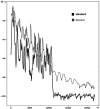Pre-attentive and Attentive Auditory Event-related Potentials in Children With Attention-Deficit Hyperactivity Disorder and Autism
- PMID: 38755963
- PMCID: PMC11459870
- DOI: 10.1177/15500594241255499
Pre-attentive and Attentive Auditory Event-related Potentials in Children With Attention-Deficit Hyperactivity Disorder and Autism
Abstract
Abnormalities in auditory processing are believed to play a major role in autism and attention-deficit hyperactivity disorder (ADHD). Both conditions often co-occur in children, causing difficulties in deciding the most promising intervention. Event-related potentials (ERPs) have been investigated and are showing promise to act as potential biomarkers for both conditions. This study investigated mismatch negativity (MMN) using a passive listening task and P3b in an active auditory go/no-go discrimination task. Recordings were available from 103 children (24 females): 35 with ADHD, 27 autistic, 15 autistic children with co-occurring ADHD, and 26 neurotypical (NT) children. The age range considered was between 4 and 17 years, but varied between groups. The results revealed increases in the MMN and P3b amplitudes with age. Older children with ADHD exhibited smaller P3b amplitudes, while younger autistic children showed reduced MMN amplitudes in response to phoneme changes compared to their NT counterparts. Notably, children diagnosed with autism and ADHD did not follow this pattern; instead, they exhibited more similarities to NT children. The reduced amplitudes of phonetically elicited MMN in children with autism and reduced P3b in children with ADHD suggest that the two respective ERPs can act as potential biomarkers for each condition. However, optimisation and standardisation of the testing protocol, as well as longitudinal studies are required in order to translate these findings into clinical practice.
Keywords: P3b; attention-deficit hyperactivity disorder; autism; mismatch negativity; phonemes.
Conflict of interest statement
Declaration of Conflicting InterestsThe authors declared no potential conflicts of interest with respect to the research, authorship, and/or publication of this article.
Figures





References
-
- Salazar de Pablo G, Pastor Jordá C, Vaquerizo-Serrano J, et al. Systematic review and meta-analysis: efficacy of pharmacological interventions for irritability and emotional dysregulation in autism spectrum disorder and predictors of response. J Am Acad Child Adolesc Psychiatry. 2022;62(2):151–168. doi:10.1016/j.jaac.2022.03.033 - DOI - PubMed
-
- Schall U. Is it time to move mismatch negativity into the clinic? Biol Psychol. 2016;116:41-46. doi:10.1016/j.biopsycho.2015.09.001 - PubMed
-
- Leung S, Cornella M, Grimm S, Escera C. Is fast auditory change detection feature specific? An electrophysiological study in humans. Psychophysiology. 2012;49(7):933-942. doi:10.1111/j.1469-8986.2012.01375.x - PubMed
MeSH terms
LinkOut - more resources
Full Text Sources
Medical
Research Materials

